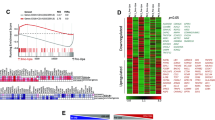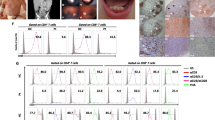Abstract.
Objective: To investigate whether lymphocytes could directly cause the destruction of bone cells in collageninduced arthritis (CIA) mice and the mechanism of this destruction.
Methods: Arthritis was induced with chick type II collagen in Kunming mice. The activities of TNF-α and IFN-γ were measured by biological methods. The mRNA of TNF-α, IFN-γ, T-bet, a Th1 specific transcription factor and Fas was detected by reverse transcript-polymerase chain reaction (RT-PCR). Matrix metalloproteinase (MMP)-9 was measured by gelatin zymography assay. The cytotoxicity of spleen cells to bone cell populations and the proliferation of spleen cells against chick type II collagen (CII) were examined by 3-(4, 5-dimethyl-2-thiazolyl)-2, 5-diphenyl-2H-tetrazolium bromide (MTT) method.
Results: Arthritis was successfully induced by chick CII in Kunming mice, which had remarkable paw swelling and typical features of arthritis. Compared with naive mice, the arthritic mice showed an increased IFN-γ and TNF-α production in serum, and the spleen cells from the arthritic mice displayed a Th1 cytokine profile and directly damaged bone cells in vitro. Interestingly, naive spleen cells treated by phorbol 12-myristate 13-acetate (PMA) also damaged bone cells as did spleen cells from CIA mice. Cyclosporine A blocked the cytotoxicity of spleen cells from CIA mice to bone cells. Only anti-CD4 and complement system together inhibited the effect of spleen cells from CIA mice on bone cells. Only the spleen cells from arthritic mice could proliferate against chick CII. In addition, the culture supernatants from spleen cells of arthritic mice contained a higher activity of MMP-9 and production of NO than those of naive mice. PMA elevated the activity of MMP-9 but not the production of NO in naive spleen cells. Moreover, the activities of TNF-α, IFN-γ and MMP-9 but not the production of NO were higher in joint tissues of arthritic mice than those of naive mice. TNF-α and IFN-γ significantly elevated the activity of MMP-9 in spleen cells from both arthritic and naive mice in vitro. Moreover, only anti-MMP-9 but not anti-MMP-2 antibody inhibited the cytotoxicity of spleen cells from CIA mice to bone cells.
Conclusions: The elevated proinflammatory factors such as TNF-α and IFN-γ may promote the MMP-9 activity in local inflammatory cells that are actually involved in the bone cell damage in CII-induced arthritis.
Similar content being viewed by others
Author information
Authors and Affiliations
Corresponding author
Additional information
Received 9 December 2003; returned for revision 20 June 2004; accepted by M. Katori 30 July 2004
Rights and permissions
About this article
Cite this article
Chen, J., Zhang, X.M. & Xu, Q. Involvement of lymphocytes with a Th1 cytokine profile in bone cell damage associated with MMP-9 production in collagen-induced arthritis. Inflamm. res. 53, 670–679 (2004). https://doi.org/10.1007/s00011-004-1311-z
Issue Date:
DOI: https://doi.org/10.1007/s00011-004-1311-z




